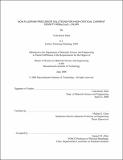| dc.contributor.advisor | Michael J. Cima. | en_US |
| dc.contributor.author | Patta, Yoda Rante | en_US |
| dc.contributor.other | Massachusetts Institute of Technology. Dept. of Materials Science and Engineering. | en_US |
| dc.date.accessioned | 2009-01-26T22:01:36Z | |
| dc.date.available | 2009-01-26T22:01:36Z | |
| dc.date.copyright | 2008 | en_US |
| dc.date.issued | 2008 | en_US |
| dc.identifier.uri | http://hdl.handle.net/1721.1/44207 | |
| dc.description | Thesis (S.M.)--Massachusetts Institute of Technology, Dept. of Materials Science and Engineering, 2008. | en_US |
| dc.description | This electronic version was submitted by the student author. The certified thesis is available in the Institute Archives and Special Collections. | en_US |
| dc.description | In title on t.p., double underscored "x" appears as subscript. | en_US |
| dc.description | Includes bibliographical references (p. 68-71). | en_US |
| dc.description.abstract | The past two decades have seen advancements in high temperature superconducting cables for use in applications such as electrical transmission lines, propulsion systems, and mobile power generation systems. This work describes the development of a non-fluorine precursor solution for YBCO films with high critical current densities (Jc). An aqueous nitrate precursor solution system was selected from three possible precursor solution systems. It was further developed to produce YBCO films with Jc > 1 MA/cm2. Films up to ~800 nm thickness were made, and Jc > 1 MA/cm2 was obtained for films of over ~400 nm thickness. The developed aqueous solution contained a rheology modifier (hydroxyethyl cellulose / HEC), nitrates of Y, Ba, and Cu, and chelating agents (polyethylene glycol / PEG and sucrose). The total organic content was ~12 wt% of the entire solution, and the total cation concentration was ~0.7 M. The rheology modifying polymer determined the thickness of the deposited films. This allowed for the deposition of films with higher thickness than would be dictated by the total dissolved cations alone. A low temperature decomposition process was developed based on analyses of the chemical reactions that take place in the precursor films as they were heated. This process produced smooth and defect-free intermediate films that were stable under ambient conditions. These films were then heat treated to convert them into YBCO films. Recommendations for future work include further improvements to the precursor solution, including more effective chelating agents and possible alternative solvent systems. Intermediate films thicker than 2.5 [mu]m still tended to have surface defects. | en_US |
| dc.description.abstract | (cont.) Additional in-depth thermal analysis would further show how these defects develop, and adjustments to the decomposition process could be made accordingly. High resolution plan-view and cross-sectional microstructures of the films between the precursor state and their converted forms is recommended. These future studies will be valuable in further improving the performance and thickness of films derived from the non-fluorine precursor solution developed in this thesis. | en_US |
| dc.description.statementofresponsibility | Yoda Rante Patta. | en_US |
| dc.format.extent | 71 p. | en_US |
| dc.language.iso | eng | en_US |
| dc.publisher | Massachusetts Institute of Technology | en_US |
| dc.rights | M.I.T. theses are protected by
copyright. They may be viewed from this source for any purpose, but
reproduction or distribution in any format is prohibited without written
permission. See provided URL for inquiries about permission. | en_US |
| dc.rights.uri | http://dspace.mit.edu/handle/1721.1/7582 | en_US |
| dc.subject | Materials Science and Engineering. | en_US |
| dc.title | Non-fluorine precursor solutions for high critical current density REBa₂Cu₃O₇₋x̳ films | en_US |
| dc.type | Thesis | en_US |
| dc.description.degree | S.M. | en_US |
| dc.contributor.department | Massachusetts Institute of Technology. Department of Materials Science and Engineering | |
| dc.identifier.oclc | 277139561 | en_US |
